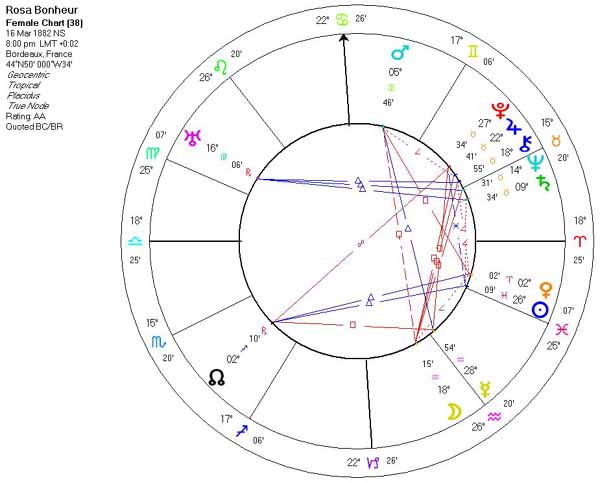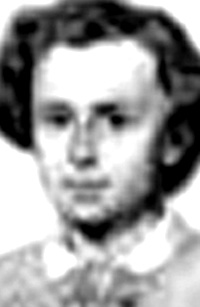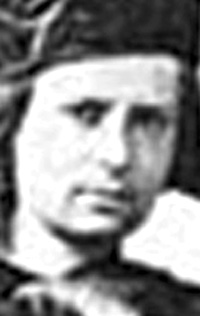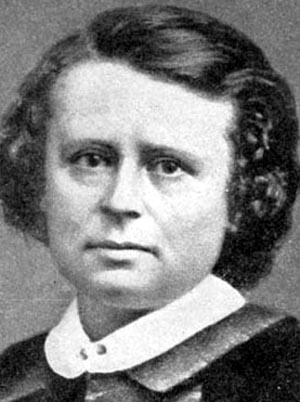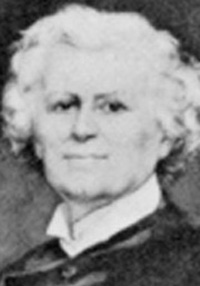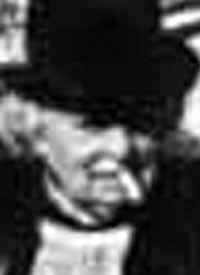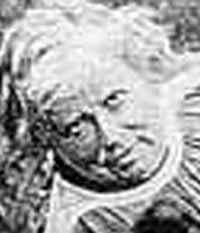Copyright Michael D. Robbins 2005
Astro-Rayological Interpretation & Charts
Quotes
Biography
Images & Physiognomic Interpretation
But the suit I wear is my work attire, and nothing else.
I preferred to preserve my name.
I was forced to recognize that the clothing of my sex was a constant bother. That is why I decided to solicit the authorization to wear men's clothing from the prefect of police.
The epithets of imbeciles have never bothered me.
I preferred to preserve my name.
- Bonheur's standard reply when questioned as to why she hadn't marriedTo his doctrines I owe my great and glorious ambition for the sex to which I proudly belong and whose independence I shall defend until my dying day.
written about her father, the only art teacher under whom she, a female, had been allowed to studyWhen Rosa was 37 years of age she commented:
Art is absorbent-a tyrant. It demands heart, brain, soul, body, the entireness of its rotary. Nothing less will win its hightest favor. I wed art. It is my husband - my world - my life dream - the air I breathe. I know nothing else. My soul finds in it the most complete satisfaction. I married art...what could I do with any other Husband?
Marie-Rosalie Bonheur, usually called Rosa Bonheur (March 16, 1822 - May 25, 1899) was a French realist painter and sculptor. Her father was a landscape painter taught by Henri de Saint-Simon. She was the sister of artist Auguste Bonheur and sculptor Isidore Jules Bonheur and the instructor of Anna Elizabeth Klumpke, with whom she later resided.
She was taught to paint by her father since, as a female, she could not at the time attend art school. She showed a great affinity for animals, and made them her specialty. She was influenced by the English animal painter Edward Landseer. She also studied animal anatomy by visiting slaughterhouses and performing dissections. She prepared sketches by such means, as well as from life, and prepared detailed studies before beginning to work on her paintings and sculptures. [1] [2]
Rosa Bonheur received a French government commission which lead to her first great success, the Horse Ploughing at the Nivernais, exhibited in 1849. Her most famous work was the monumental Horse Fair, completed in 1855, which measured eight feet high by sixteen feet wide.[3] It led to international fame and recognition and that same year she travelled to Scotland, enroute meeting Queen Victoria, who admired her work, and where she completed sketches for later works including A Scottish Raid completed in 1860, and Highland Shepherd. These were anachronistic pieces, as they depicted a way of life in the Scottish highlands that had disappeared a century earlier. Nonetheless, they had enormous appeal to Victorian sensibilities. She was especially popular in England and less so in her native France.
She was considered the most famous woman artist of her time (Janson, 674). She was represented by private art galleries, and in particular that of Ernest Gambart (1814-1902), which would purchase the reproduction rights to her work and sell engraved copies of her paintings. It was Gambart who brought Bonheur to the United Kingdom in 1855.[4] Many engravings were created by the skillful Charles George Lewis (1808-1880), one of the finest engravers of his day. Gambart sold through his gallery in London's Pall Mall.
Bonheur is perhaps most famous today because she was known for wearing men's clothing, and is now seen as an early feminist. She said at the time that this was simply practical, as it facilitated her work with animals: "I was forced to recognize that the clothing of my sex was a constant bother. That is why I decided to solicit the authorization to wear men's clothing from the prefect of police. But the suit I wear is my work attire, and nothing else. The epithets of imbeciles have never bothered me...." (Janson, 929)
She lived for fifty years with her female companion Nathalie Micas at her country estate near Fontainebleau. After Micas' death, she taught and lived with the American painter Anna Elizabeth Klumpke. She died at the age of 77. Many of her paintings, which had not been shown publicly, were sold at auction in Paris in 1900.
Rosa (Marie Rosalie) Bonheur was born March 16th 1822 in Bordeaux, France. She is widely acclaimed as an animal painter and was influenced by the work of the English artist, Landseer.
Rosa Bonheur was one of the most renowned animal painters in history. Her earliest training was received from her father, a minor landscape painter, who encouraged her interest in art in general and in animals as her exclusive subject. He allowed her to keep a veritable menagerie in their home, including a sheep that is reported to have lived on the balcony of their sixth-floor Parisian apartment.
Bonheur's unconventional lifestyle contributed to the myth that surrounded her during her lifetime. She smoked cigarettes in public, rode astride, and wore her hair short. To study the anatomy of animals, Bonheur visited the slaughterhouse; for this work, she favored men's attire and was required to obtain an official authorization from the police to dress in trousers and a smock.
While radical in her personal life, Bonheur was artistically conservative. Henri Cain would later recall that she "was not only an exceedingly intelligent artist, but a very conscientious and hard-working one....She believed in honesty in art and ever desired to keep very close to nature." Bonheur's reputation grew steadily in the 1840's; she exhibited her animal paintings and sculptures at the Paris Salon regularly from 1841 to 1853. The Salons tended to support traditional styles, and most artists still sought to exhibit at the annual shows, as it was the primary way for their work to be seen by the public. In 1845 Bonheur won a third prize and in 1848 a gold medal.
Because of this recognition from official sources, she was then awarded a commission from the French government to produce a painting on the subject of plowing. Plowing in Nivernais, exhibited at the Salon of 1849, firmly established her career in France. Bonheur later won international acclaim with her life size painting The Horse Fair exhibited at the 1853 Salon.
Bonheur's popularity in England was assured after two versions of The Horse Fair were exhibited there, and Queen Victoria ordered a private viewing of the original at Windsor Castle. The artist's chief source of revenue in the 1860s and 1870s came from sales in England rather than from her native France. In 1894 she was the first woman to receive the Grand Cross of the French Legion of Honor.
Sheep by the Sea illustrates Bonheur's lifelong interest in portraying farm animals in a straightforward manner, reinforcing her commitment to direct observation from nature. She has captured the essence of a flock of domestic sheep--calm, undisturbed, and complacent--settled in a meadow on the edge of a body of water.
The Horse Fair (1835-55) and Weaning the Calves (1887) are both in the Metropolitan Museum of Art, New York City.
Rosa (Marie Rosalie) Bonheur (1822 - 1899) was born March 16th 1822 in Bordeaux, France. She was the sister of Isidore Jules Bonheur and is widely acclaimed as an animal painter who was influenced by the work of the English artist Landseer. It is very unusual that at an early age she was enrolled in a small private school for boys and was the only girl there. She was expelled from school because of her unruly "tomboyish" behavior. She adopted the unusual custom of dressing in Men's clothing and forced herself in to the world of sculpture, which up until her time was considered to be a man's work. She even performed dissections of animals to gain the intimate knowledge of their muscle and bone structure as Barye and Fremiet were doing. She even went so far as to frequent the slaughter houses of Paris to view the animals in various states of processing. Her habit of dressing in waistcoat and trousers persisted throughout her lifetime and in fact she even obtained the permission of the Perfect of Police in Paris to dress so. On one occasion, while attired in a dress, she was arrested by a Gendarme who mistook her for a man masquerading as a woman.
Rosa Bonheur submitted her first painting to the Salon in 1841 at age of 19. The following year, 1842, she submitted her first sculpture, a terra-cotta of a Shorn Sheep Grazing. The 1843 Salon saw the plaster model of her Bull, which was later cast in bronze by her brother-in-law Peyrol. She was awarded a Third Class Medal at the 1843 Salon for her exhibit of three paintings and two sculptures and given a State Commission for a painting. She continued to exhibit her paintings, gaining enormous acclaim as an artist, but it wasn't until the 1848 Salon that she exhibited more sculpture where she entered two models and received the Gold Medal of the First Class. Only thirteen of her sculptural works survive and of those only seven were ever exhibited in her lifetime but her influence and vitality were far reaching. Her few bronze sculptures were not cast in large editions and are highly sought after by collectors today. She was thought to be romantically associated with Buffalo Bill Cody as well as Edward Landseer but she lived for 50 years with her life long friend and close companion Nathalie Micas. She was a great patron and example to the numerous young American women sculptors working and studying in Paris in the late 19th century. Her naturalism and realism in both painting and sculpture assured a world wide market for her work, which commanded high prices even during her lifetime. Rosa was patronized and befriended by Queen Victoria after her first visit to Scotland in 1853.
It is unfortunate that she was mostly dismissed by the art world in France during her lifetime but succeeded in gaining the respect of the rest of Europe, England and the United States where she sold most of her works. She left Paris in 1860 settling in the Forest of Fontaineblue where she was surrounded by her animals both domestic and some wild lions, bears and others until her death. Her exhibits and awards include the Great Exhibit of London in 1862, the Paris Exposition Universelle 1867, and the Chicago Words Colombian Exposition in 1893. In her later years she was presented with the Cross of an Officer of the Legion of Honor. Rosa Bonheur was a fiercely independent individual and an eccentric character in both person and dress. As was with the case with her brother's bronzes, her bronze sculpture was also cast by Hippolyte Peyrol and bare his foundry mark. She signed her bronzes Rosa B.
Born:March 16, 1822, Bordeaux
Died:1899 Château de By near FontainebleauAs a child, Rosa Bonheur sketched animals in the wild. In 1848 she won a gold medal, and in 1853 she achieved international acclaim with her 96" x 199" painting, The Horse Fair now owned by the Metropolitan Museum of Art in New York. The energy and power of the draftsmanship of her horses reflect the great influence of Théodore Géricault whose study of horses was in her studio at the time. Bonheur was also familiar with engravings such as George Stubbs’ 1794 Godolphin Arabian and Catlin’s native American subjects.
Direct observation from nature was favored by artists in the 1830s and 1840s; it remained a principle to which Bonheur adhered throughout her life. She knew and influenced many American artists who studied in Paris in the late nineteenth century. and was herself a frequent visitor to the American spectacle of Buffalo Bill’s Wild West Show when it came to Paris.
At her chateau, now the Rosa Bonheur Museum, she received a notable honor presented by Empress Eugénie in June 1865--the Cross of the French Legion of Honor. She was so popular in the 19th century that ‘Rosa’ dolls were made in her image. Near the end of her life she speculated that "her critics could forgive her everything but being a woman.”
